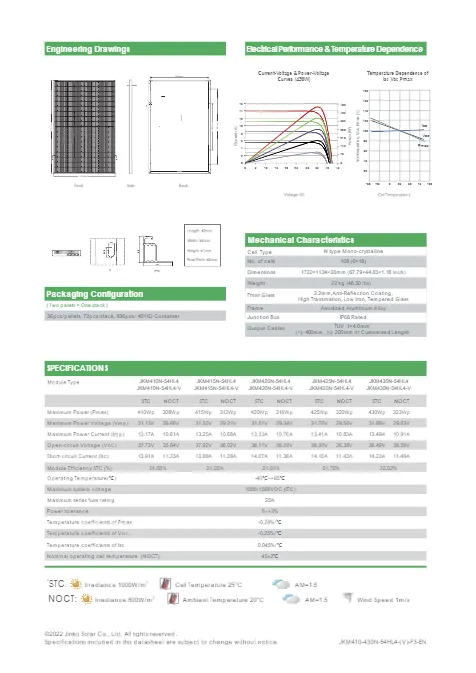How Solar Panels Are Manufactured and Their Components Explained
How Solar Panels Are Made
Solar panels, also known as photovoltaic (PV) panels, are essential components of solar energy systems that convert sunlight into electricity. As the global demand for clean and renewable energy sources grows, understanding the manufacturing process of solar panels becomes increasingly important. This article will explore how solar panels are made, from the raw materials to the final product ready for installation.
Raw Materials
The primary material used in solar panels is silicon, which is derived from silica, a compound found abundantly in sand. Silicon is chosen for its semiconductor properties, which are critical for the photovoltaic effect. The manufacturing process begins with the extraction of silica, which is then processed and refined to produce high-purity silicon. This silicon is often manufactured in the form of ingots or wafers, which are used to create solar cells.
In addition to silicon, other materials are necessary for solar panel production, such as glass, aluminum, and conductive metals. Glass is used to cover the panels and protect the delicate solar cells from environmental factors, while aluminum frames provide structural support. Conductive metals, such as silver or copper, are used to create the electrical connections between the solar cells.
Silicon Ingot Formation
The first step in solar panel production is converting silicon into ingots. This process typically involves either the Czochralski method or the casting method. The Czochralski method involves melting high-purity silicon and using a seed crystal to grow a cylindrical ingot. This method produces monocrystalline silicon ingots, which are known for their high efficiency and performance.
Alternatively, the casting method involves pouring molten silicon into molds to create larger blocks called solar-grade silicon. This method typically yields multicrystalline silicon, which, while slightly less efficient than monocrystalline silicon, is more cost-effective to produce.
Wafer Production
Once the silicon ingots have been formed, they are cooled and sliced into thin wafers using precision saws. These wafers, typically around 200 micrometers thick, serve as the foundational building blocks for solar cells. The thickness of the wafers is crucial, as it impacts both the efficiency and the overall cost of the solar panels.
solar panels how are they made

After slicing, the wafers undergo a process called doping, which involves adding small amounts of other materials, such as phosphorus or boron, to create a positive (p-type) or negative (n-type) silicon layer. This doping process enhances the semiconductor properties of the silicon, allowing it to generate electricity more effectively.
Solar Cell Fabrication
The next step is to convert the silicon wafers into solar cells. This process involves several techniques, including texturing, anti-reflective coating application, and metallization. Texturing the surface of the wafers creates a rough texture that helps capture more sunlight by reducing reflection.
Following this, an anti-reflective coating is applied to the surface of the solar cells to enhance light absorption. The final step in solar cell fabrication is metallization, where conductive metal contacts are printed onto the surface of the cells. These contacts enable the flow of electricity generated when light hits the cells.
Assembling Solar Panels
After the solar cells have been fabricated, they need to be assembled into solar panels. First, the cells are arranged in a grid-like pattern on a backing material, usually made of durable polymers. This backing provides insulation and protection for the cells. The cells are then interconnected using conductive ribbons to ensure efficient electrical flow between them.
Once the solar cells are interconnected, the assembly is encapsulated using ethylene-vinyl acetate (EVA) to provide additional protection against moisture, dirt, and other environmental factors. The entire assembly is then covered with a layer of tempered glass, which shields the solar cells from mechanical damage and the elements.
Final Touches
The final step in solar panel manufacturing involves testing and quality assurance. Each panel undergoes rigorous testing to ensure it meets the necessary performance standards and specifications. Once the panels have passed these tests, they are trimmed, framed, and packaged for distribution.
In summary, the process of making solar panels involves the transformation of raw silicon into efficient solar cells, followed by assembly into protective panels. As technology advances and manufacturing processes improve, the production of solar panels is becoming more efficient and cost-effective, contributing significantly to the transition towards renewable energy sources worldwide. With the ever-increasing focus on sustainability, understanding how solar panels are made highlights the importance of clean energy in combating climate change and preserving our planet for future generations.
-
Unlocking Energy Freedom with the Off Grid Solar InverterNewsJun.06,2025
-
Unlock More Solar Power with a High-Efficiency Bifacial Solar PanelNewsJun.06,2025
-
Power Your Future with High-Efficiency Monocrystalline Solar PanelsNewsJun.06,2025
-
Next-Gen Solar Power Starts with Micro Solar InvertersNewsJun.06,2025
-
Harnessing Peak Efficiency with the On Grid Solar InverterNewsJun.06,2025
-
Discover Unmatched Efficiency with the Latest String Solar InverterNewsJun.06,2025







